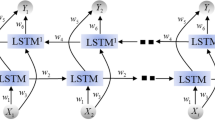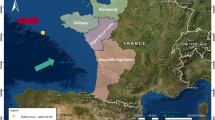Abstract
Weather forecasting is critical for, for example, the operation of hydroelectric power plants and flood control. Mechanical structures are considered to be challenging in computational terms. Developing models can predict weather conditions quicker than conventional meteorological models which is therefore of interest. The Field of Machine Learning has generated a great deal of attention from the scientific community. It is our aim to research whether an artificial neural network has a good potential for forecasting weather conditions in addition of large datasets, due to its applicability in a number of fields. It is a benefit to have meteorological data available from through online outlets.
Access this chapter
Tax calculation will be finalised at checkout
Purchases are for personal use only
Similar content being viewed by others
References
McGovern A, Elmore KL, Gagne DJ, Haupt SE, Karstens CD, Lagerquist R, Smith T, Williams JK (2017) Using artificial intelligence to improve real-time decision-making for high-impact weather. Bullet Am Meteor Soc 98(10):2073–2090
Maqsood I, Khan MR, Abraham A (2003) Weather forecasting models using ensembles of neural networks. Intell Syst Design Appl 33–42. Springer, Berlin
Selvi K, Suresh RM (2016) Fuzzy concept lattice for ontology learning and concept classification. Indian J Sci Technol 9(28):1–7
Scher S, Messori G (2018) Predicting weather forecast uncertainty with machine learning. Quarter J Royal Meteorol Soc 144(717):2830–2841
Liu F, Xu F, Yang S (2017) A flood forecasting model based on deep learning algorithm via integrating stacked autoencoders with BP neural network. In: Proceedings of 2017 IEEE Third International Conference on Multimedia Big Data (BigMM), pp 58–61
Zhang D, Kabuka MR (2018) Combining weather condition data to predict traffic flow: a GRU-based deep learning approach. IET Intell Trans Syst 12(7):578–585
Salman AG, Kanigoro B, Heryadi Y (2015) Weather forecasting using Deep Learning Techniques. Advan Comput Sci Infor Syst (ICACSIS) 281–285
Sundaram A, Ramesh GP (2020) Investigation of solar based SL-QZSI fed sensorless control of BLDC motor. Part of the Advances in Intelligent Systems and Computing book series (AISC) Vol 1125, pp779–787, Springer
Hossain M, Rekabdar B, Louis SJ, Dascalu S (2015) Forecasting the weather of Nevada: a Deep Learn App. In: Proceedings of 2015 IEEE International Joint Conference on Neural Networks (IJCNN), pp 1–6
Hemanth kumar G, Ramesh GP (2019) Reducing power feasting and extend network life time of IoT devices through localization. Inter J Adv Sci Technol 28(12):297–305
Mikolov T, Karafiát M, Burget L, Černocký J, Khudanpur S (2010) Recurrent neural network based language model. In: Proceedings of the 11th Annual Conference of the International Speech Communication Association, pp.1045–1048.
Gers FA, Schmidhuber J, Cummins F (1999) Learning to forget: continual prediction with LSTM. In: 1999 IEEE Ninth International Conference on Artificial Neural Networks ICANN 99, (Conf. Publ. No. 470), pp 850–855
Graves A, Schmidhuber J (2005) Framewise phoneme classification with bidirectional LSTM and other neural network architectures. Neural Networks Elsevier 18(5–6):602–610
Kalpana A V, Rukmani Devi S, Indira N (2019) A unique 3D localization in wireless sensor networks using adaptive stochastic algorithm. Appl Math & Infor Sci 13(4):236–242
A.V. Kalpana, S Rukmani Devi, N Indira, (2020) Robust 3d localization using cubical geometry in wireless sensor networks. Solid State Technol 63(6):18846–18874
Kalpana A V, Rukmani Devi S, Indira N (2018) An efficient localization for smart defense node connection based node position tracking and identification in wireless sensor networks. J Web Eng 17(6):2452–2471
Indira N, Rukmanidevi S, Kalpana AV (2020) Light weight proactive padding based crypto security system in distributed cloud environment International J Comput Intell Syst 13(1):36–43
Indira N, Rukmani Devi S, Kalpana AV (2020) R2R-CSES: proactive security data process using random round crypto security encryption standard in cloud environment. J Ambient Intell Human Comput, Springer, pp 1–12
De Baets L, Ruyssinck J, Peiffer T, Decruyenaere J, De Turck F, Ongenae F, Dhaene T (2016) Positive blood culture detection in time series data using a BiLSTM network. arXiv preprint arXiv:1612.00962
Selvi K, Suresh RM (2016) Strategies for effective document clustering using modified neural network algorithm. J Comput Theoret Nanosci 13(7):4169–4176
Sampath S, Murugan S (2013) Similarity measure using fuzzy formal concept for any context. Int J Adv Comput Sci (IJACS) 3(12):607–613. ISSN: 2251–6379
Author information
Authors and Affiliations
Corresponding author
Editor information
Editors and Affiliations
Rights and permissions
Copyright information
© 2021 The Author(s), under exclusive license to Springer Nature Singapore Pte Ltd.
About this paper
Cite this paper
Selvi, S., Bala Nivetha, V., Divya, R., Gayathri, S., Pavithra, G.S. (2021). Change Point Detection Technique for Weather Forecasting Using Bi-LSTM and 1D-CNN Algorithm. In: Kumar, R., Mishra, B.K., Pattnaik, P.K. (eds) Next Generation of Internet of Things. Lecture Notes in Networks and Systems, vol 201. Springer, Singapore. https://doi.org/10.1007/978-981-16-0666-3_11
Download citation
DOI: https://doi.org/10.1007/978-981-16-0666-3_11
Published:
Publisher Name: Springer, Singapore
Print ISBN: 978-981-16-0665-6
Online ISBN: 978-981-16-0666-3
eBook Packages: Intelligent Technologies and RoboticsIntelligent Technologies and Robotics (R0)




